Horses stabled for long periods can become bored and frustrated, especially when their exercise or interactions with other horses are limited. This can be particularly challenging when a horse is on box rest, as Sophie experienced with her horse Chuck.
Chuck's injury in June 2022 was a traumatic experience. He suffered significant skin, nerve, and lymph damage to his lower right hind leg, requiring extensive care and attention. Differing opinions from vets created more difficulties, however after thorough consultation Sophie decided to follow the second vet's advice, and Chuck began eight weeks of box rest.
As previously discussed in our last blog, it is important for us to consider how we can improve the box rest process and make it less stressful for our horses. Enrichment allows us to provide activities and objects that promote natural behaviours and positively contribute to our horse’s physical and mental needs. To improve Chuck’s wellbeing, Sophie had to get creative and began exploring the different ways to enrich his environment.
If competing check your governing body's rules regarding Clean Sport for Horses and avoid using essential oils near pregnant mares.
What more can we do to provide for our horses if they need to be stabled?
Enrichment creates a greater variety and choice and positively contributes towards a horse’s physical and mental needs.
To provide for our horses while they are stabled, it is important to offer a variety of options that can occupy their minds and reduce stress. If you are new to exploring enrichment for your horse, be sure to read our guide on how to introduce these safely. Here are a few of Sophie and Chucks tried and tested ideas that you could introduce to your horse:
- Pack a traffic cone with hay, leaving some poking out of the top and hiding treats inside.
- Make root vegetable kebabs by threading carrots, parsnips, and turnips onto a strong cord or rope and hanging them from the stable ceiling. To help prevent the risk of choke, this type of enrichment should only be provided to horses with good teeth. Where possible fruit and vegetables should be sliced lengthways, but if fed in whole pieces, it’s important to feed when someone is present on the yard.
- Put horse-safe logs and suitable branches, such as willow or hazel, around the stable for your horse to browse on. Part of their natural diet would include bark and branches.
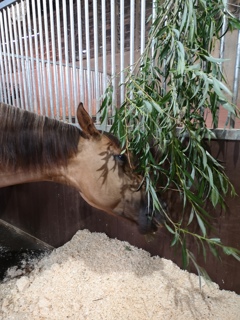
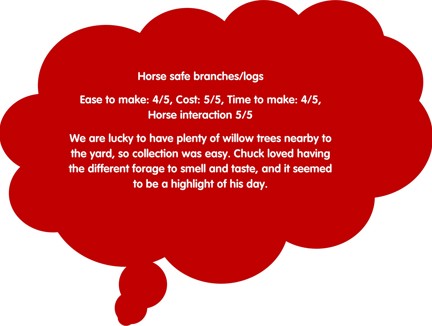
- Make some stable treats by smearing banana along your stable railings and sticking vegetable treats or Polos on it. Add something different every day and see what your horse likes best.
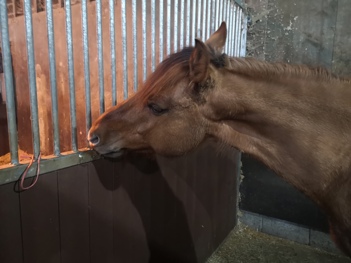
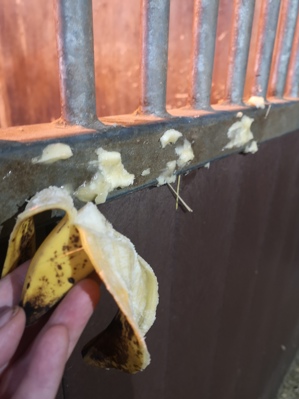
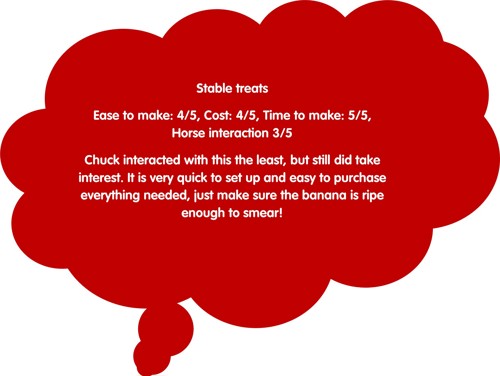
- Hide treats inside staple- free cardboard boxes. Collect suitable, non-poisonous shrubs such as cow-parsley, cleavers, mint, and dandelions, and place them amongst your horse's forage ration. Find out what your horse enjoys the most and cut something different for them every day.

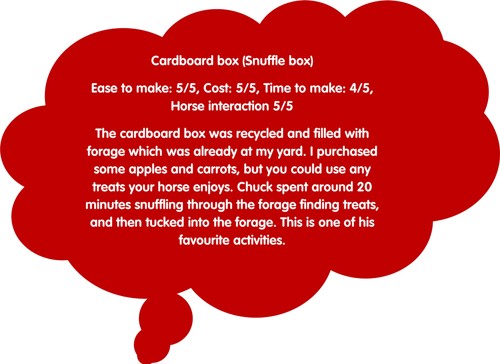
- Hiding strips of root vegetables or grass nuts in their bed and forage ration will extend foraging time.
- While you can buy a stable toy for your horse, make sure they are easy to access. Some horses can become frustrated if they are too challenging to use.
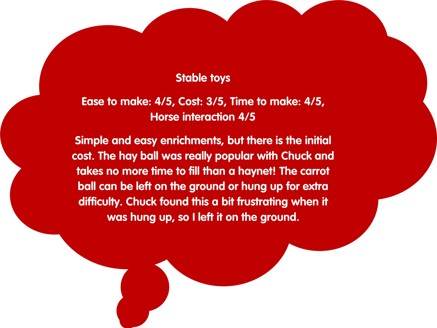
Remember, always supervise your horse, and don't provide anything that could cause choke or injury for example sharp branches. Avoid using sugary treats if your horse is laminitic or on a restricted weight management plan and if introducing anything new to your horse’s diet make sure this is done gradually (ideally over 10-14 days) to reduce the risk of colic.
Navigating your way through box rest
Going through this experience was tough for both Chuck and Sophie and as we will explore later in this series despite huge efforts from Sophie to provide enrichment activities, Chuck started to become aggressive, fearful and vet phobic. This highlights the importance of monitoring your horse closely and if you start to see changes in their behaviour, ask for support immediately, to prevent things escalating and potentially becoming a big problem. Equine behaviourists like Justine Harrison will help you understand your horse’s behaviour and will work with you to tailor a safe, effective programme for both you and your horse's individual circumstances. Find a registered accredited equine behaviourist local to you through the Animal Behaviour and Training Council.
Recovering from a catastrophic injury requires patience, persistence, and a lot of emotional strength. It can be challenging to see your beloved horse in pain and struggling to recover, and it's essential to have support during this time. The BHS Horse Care and Welfare Team are here to help and can offer you further advice and support to help navigate the ups and downs of having your horse on box rest. Contact us using the information below.
Responding to changes in your horse’s behaviour
With the support of Accredited Equine Behaviourist Justine Harrison, we delve into the potential impacts of box rest on our horse’s mental wellbeing. Listen along as we start an open conversation on:
- The challenges of box rest
- Changes in our horse’s behaviour – what to look out for and how to overcome or prevent these.
- Seeking support
- Is box rest always the best option for our horse? What alternative options can we consider?
 play-circle
play-circle
Watch
Supported by Qualified Equine Behaviourist Justine Harrison CEBC ABTC-AAB
Get in touch – we’re here to help
The BHS Horse Care and Welfare Team are here to help and can offer you further advice with any questions you may have. Contact us on 02476 840517* or email welfare@bhs.org.uk – You can also get in touch with us via our social media channels.
Opening times are 8:35am - 5pm from Monday – Thursday and 8:35am - 3pm on Friday.
*Calls may be recorded for monitoring purposes.
